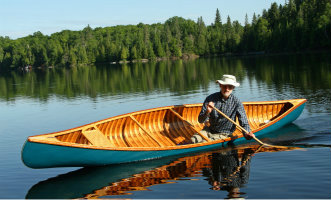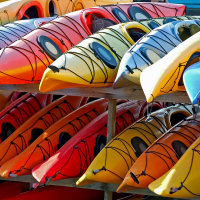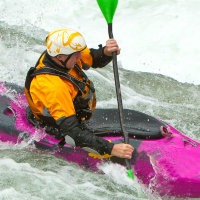Inflatable Kayak Valves, Pumps & Repairs
Your inflatable kayak should be easy to set up if you choose the right pump and attachments to fit the valves used by your particular model. Check with your outfitter what connectors you use or if buying on line check these aspects out when it arrives and well before you plan to use it to avoid finding you don't have the right parts when you need them. Have a couple of practices at inflating your kayak at home on a dry warm day when you can take your time and not get stressed if it doesn't all go according to plan. That way when you get to use it for the first time you will enjoy your outing.
Inflating your Kayak
Many inflatable kayaks come as packages complete with a pump and repair kit. Your bike or car tyre pump won't work as it doesn't have the right connectors. Ideally if you have a pressure gauge check what pressure your kayak should be inflated to, however, bear in mind that if you leave your kayak in the sun the pressure will increase as it warms up so start off a little lower than advised (and left in the hot sun IT WILL BURST, you have been warned). Likewise if you are using it in very cold water the cooling may reduce the pressure so you may want to go a little higher to start with. If you don't have a pressure gauge, pump the kayak up until good and firm but not ridiculously solid, then try holding the kayak off the floor from the centre and see if it sags in the middle. If it sags it needs to be pumped up some more.
Hand Pumps
There are two types of hand pump, double action and single action. With the double action air is delivered on both the up and the down action of the pump whilst the single action pump only delivers air on the down action. The double action pump is quicker than the single action or the foot pumps but many of the single action pumps have settings to allow for pumping air in and out. This can make deflating the kayak a more efficient process.
The two way pump is effective up to about 4psi after which it gets to be hard work. It will go higher but you will have to work hard! Above that a one way pump is more effective and will inflate your high pressure kayak up to around 10psi.
The hand pumps are larger to store than the foot pumps.
Foot Pumps
Small bellows foot pumps only fill the kayak on the downstroke but again have inflate and deflate settings. Although not as quick as the hand pumps they are small and easy to carry around. They can be popped in the back of your kayak just in case!
Electric Pumps
You can buy 12volt electric pumps that run off your car battery. These will fill your kayak most of the way quickly and easily but you will need to top up to the correct pressure with a hand or foot pump as they cannot deliver the required pressure.
Inflatable Kayak Valves
You need to make sure that you have the correct adaptor on your pump to fit the valves in your inflatable kayak. Some of the types of valve you might come across are as follows:
Military Valves
Military valves are spring loaded and have two settings. When open air can be pumped in but it will come out again as soon as the adaptor is removed. In the closed position air will only go in and not out. Electric pumps are not strong enough to work in the closed position so use them in the open position to get the chambers quite full then switch to a hand or foot pump in the closed position to bring up to the correct pressure.
Boston Valves
Boston valves are opened and closed ready to pump air in or out using a screw mechanism. After filling with air the screw fitting is tightened shut to prevent the air coming out again.
Twist and Pinch Valves
You
will also find twist lock valve on the end of some tubes for small
bladders which are twisted as their name suggests to let air in and
twisted back to close them off and Sevylor / Coleman have their own
valve and basic inflatables use pinch valves simliar to those you might
get on a beach ball or lilo where you have to pinch the valve to let air
out.
Repairs
The sort of repairs we are going to cover here are ones that result in your inflatable deflating when you don't want it to! If you have a leak it will either be from a puncture, small or large, of one of the chambers or it could be a leak around one of the valves where it joins the skin or even a leaky / faulty valve.
Firstly you need to find your leak. If it is not obvious inflate your craft then try running some soapy liquid across areas that look suspicious including around where the valves seal to the fabric. Look for bubbles forming to spot where the leak is.
If your leak is in the body of the kayak you will need to apply a patch. Many Kayaks come with a repair kit comprising of an approriate glue and material for patching. Follow the instructions don't just apply some glue and stick. If it says put glue on both sides and leave to dry, do just that. if it says be careful how you line up your patch becasue it will stick instantly...it means it! If you have lost the repair kit or it didn't come with one try the manufacturer's website to see what glues they recommend. Remember that some glues can react with some of the lighter materials and make them melt. Likewise it is good to clean up the area around the patch before patching with a solvent. BUT some solvents will melt some materials so do some research first.
If you think the leak is coming from where a Boston valve or Military valve is located try removing and re srewing in the Boston Valve ( it could be misthreaded) or tightening the Military valve up with the tool provided. Check whether your repair kit includes a replacement inflatable kayak valve. If not you can buy replacements.
- Home
- Kayaks
- Inflatable Kayak
- Inflatable Kayak Valves



